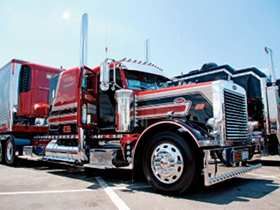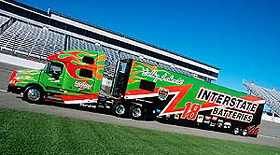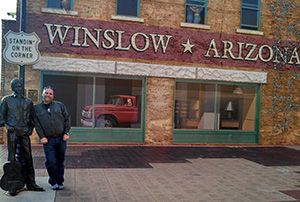Transportation Related
Topic 19155 | Page 1

RV's must have a seatbelt for each passenger in the majority of states, there are a few that have not caught up with putting it on the books. There are different laws for different buses, transit buses in all states are exempt from seatbelting in their passengers, but some states require non-local transit buses to have them and riders use them, but I doubt you will see it enforced, and most non-local buses built in the last few years have seatbelts in them as standard equipment. School Buses, different beast all together, and I can't think of 1 state that mandates use, not sure why, just no one has mandated it, yet.
For a truck - the same laws apply, as would for a passenger vehicle. Front seat occupants must wear seatbelts. Similarly for RV's - driver and front passenger seat (if so configured) are covered under the same law as passenger vehicles.
From a safety standpoint, I would rather be belted into a seat - than EJECTED from the tractor in an accident - that's some big wide open windshield real estate for you to go flying throughb. Likewise, if you are restrained in the seat, and hit some harsh bumps or other obstacles, you can still maintain control of the vehicle, instead of being thrown from the seat.
Some states now DO have laws, requiring SCHOOL BUSES to have seat belts installed (and USED).
Arkansas, California, Florida, Louisiana, New Jersey, New York, and Texas have passed some variation of a seat belt law for school buses but funding has not been appropriated in some states. In 2017, at least 28 states have introduced bills that would address seat belts on school buses.
This from: National Conference of State Legislators http://www.ncsl.org/research/transportation/school-bus-safety.aspx
Rick
Matt, maybe you noticed the details about whether passengers need seat belts. Do you realize all those drivers are required to be buckled in?
HOS:
Hours Of Service
HOS refers to the logbook hours of service regulations.
I did and it makes since. Now it does anyways I appreciate it. I to would rather be in a seatbelt and more importantly would want a passenger in a seat belt. I seen an rv the other day with about 5 people In it which would have been the capacity. So that's where the question came from

Hi Matt - I may be able add on to Rick, Errol's and Chosen's answers and help some with the "why" part of why seatbelt use is not universally required for occupants of school buses and RV's where it is for trucks, which I believe was part of your original question. Warning: This answer is long, wonky, and probably exceeds Matt's original question, but I'm looking for anything I can think of to put off doing my taxes today.
The school bus issue is the best example for the answer as there's a ton of research and policy discussion regarding occupant restraints in school buses. Simply put: it's the money. Not so simply put, it's where do school districts spend the money they have to yield the greatest benefit. School districts have limited funds to accomplish their total mission; transportation is just one part of that. Data shows that buses are by far the safest vehicle on the road in which to travel. In fact, an average of 6 of the more than 26 million K-12 students riding in buses are killed per year in school bus crashes, while an average 11 school children are killed each year by one of the estimated 450 million school buses on American roads or by other vehicles as they're approaching or boarding their bus. School buses are not required to have seatbelts installed by federal rule, making each state responsible, and as Rick pointed out, a handful have done so. Additionally, many school districts have voluntarily installed belts. So why don't the feds require the approximately 30,000 school buses purchased each year to come equipped with restraints; or why haven't more states passed laws requiring it? No one argues that seatbelts in school buses wouldn't help, so what's the hold-up?
It's the Benjamins. The cost to equip a new bus with passenger restraints is estimated to be between $7,000 - $10,000 per bus. The total national cost of compliance then would be somewhere between $210 million - $300 million per year. The typical response is you can't put a price on human life (especially our kids), so let's get it done. What school districts do is try to get the most benefit for their dollar. For instance, we already mentioned more kids are killed getting to or on the bus than do while riding on one. So, districts may opt to address the greater problem by adding more driver training, mirrors, warning lights, strobes, cameras, human spotters, and that swing out thing that keeps kids far enough in front of the vehicle for the driver to see them. They've estimated or calculated that dollars spent on those other items will prevent more fatalities than adding belts will. Buses are already involved in 9 times fewer accidents than cars, and occupants are protected by high back padded seats, which help prevent fatal injuries.
The 2014 measure of occupant fatalities per 100,000,000 (100 million) miles traveled by all buses (school, transit, charter, the 'Hound) was 0.28. By comparison, passenger auto occupant fatalities occur at nearly three times that rate, or 0.85 fatalities per 100 million miles traveled. Heavy trucks, defined by the National Highway Traffic Safety Administration (NHTSA) as vehicles with GVWR over 10,000 lb., had 0.30 occupant fatalities per 100 million miles in 2014. About the same as school buses. But, that's the rate of truck fatalities with seatbelts required to be installed and used as they have been since 1970.
Historical data from 1975 - the first year data is available for trucks - shows the fatality rate for heavy trucks was 1.2 - meaning the 2014 fatality rate of 0.30 represents a 75% decrease. The data shows the fatality rate remained 1.2 in 1980, before beginning a drastic decline in 1985 to 0.8, dropped again to 0.5 in 1990, and then to either 0.4 or 0.3 (varies back and forth year to year) from 1991 - 2014. Being trained to look for significant changes in data trends and the causation - I googled truck regulation 1984 and found that was the year the forerunner of the FMCSA was empowered to enforce the Federal Highway Administration's truck safety regulations - which I assume included seatbelt use. Coincidence? I know there have been allot of other safety improvements in heavy trucks, and it doesn't make sense that the entire drop in truck fatalities is attributable to seatbelts, but I expect it is one of the more - if not the most - significant factor(s). For example, faster access to better health care reduces fatalities irrespective of vehicle safety improvements. I only looked at fatalities for this example. Obviously, there are thousands of injuries occurring each year as well that would be included in a comprehensive analysis.
As far as RV's, there is no employee safety issue being enforced such as with OSHA does for off-roadway transport vehicles or FMCSA for on-highway trucks. I didn't find any data regarding RV occupant safety based on restraint use.
Overall, this quick analysis shows a little bit of how policy-makers identify issues to resolve through law or regulation. A big part of that is cost-benefit or cost-effectiveness analysis as presented above. But, never forget the ability of an emotional reaction to a tragedy or string of tragedy's to result in a knee-jerk reaction to a problem resulting in a new law, even when the evidence does not support or even contradicts it. Probably a long answer to a short question, but it's what I did for the last 15 years so thought I'd share it.
Take care all - Don
CSA:
Compliance, Safety, Accountability (CSA)
The CSA is a Federal Motor Carrier Safety Administration (FMCSA) initiative to improve large truck and bus safety and ultimately reduce crashes, injuries, and fatalities that are related to commercial motor vehicle
FMCSA:
Federal Motor Carrier Safety Administration
The FMCSA was established within the Department of Transportation on January 1, 2000. Their primary mission is to prevent commercial motor vehicle-related fatalities and injuries.
What Does The FMCSA Do?
- Commercial Drivers' Licenses
- Data and Analysis
- Regulatory Compliance and Enforcement
- Research and Technology
- Safety Assistance
- Support and Information Sharing
GVWR:
Gross Vehicle Weight Rating
GVWR is the maximum operating weight of a vehicle as specified by the manufacturer, minus any trailers.
Dm:
Dispatcher, Fleet Manager, Driver Manager
The primary person a driver communicates with at his/her company. A dispatcher can play many roles, depending on the company's structure. Dispatchers may assign freight, file requests for home time, relay messages between the driver and management, inform customer service of any delays, change appointment times, and report information to the load planners.Fm:
Dispatcher, Fleet Manager, Driver Manager
The primary person a driver communicates with at his/her company. A dispatcher can play many roles, depending on the company's structure. Dispatchers may assign freight, file requests for home time, relay messages between the driver and management, inform customer service of any delays, change appointment times, and report information to the load planners.HOS:
Hours Of Service
HOS refers to the logbook hours of service regulations.New Reply:
New! Check out our help videos for a better understanding of our forum features

















Preview:








 TT On Facebook
TT On Facebook
Buses as in school buses can have multiple people with no seat belts. Rvs that can be drivin I believe can have multiple people without factory installed seats with seat belts. What makes a truck different?Or is my information incorrect? There is no motive behind this question other than curiosity.